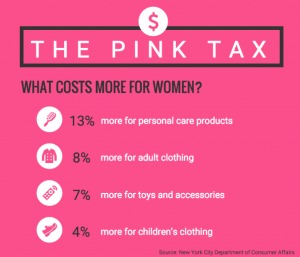By Caroline Turner
I took a trip to Target last night and I unknowingly got wrapped up in some sort of pink trap.
As soon as I walked in I checked out the “deals” section in the front. Now looking back, I can’t help wondering why there was there so much pink?! The entire sale section had a few themes: back to school for teachers, back to school for girls, summer party, and kids’ toys. Just glancing at the toys section, I could tell it was for boys, with images of cars in dark blue and red color schemes. The section I got caught in was definitely geared for girls. I bought two packs of stationary cards as well as a few things for a friend’s upcoming birthday. The intended event of the cards was left semi- general, but they were in hot pink, and other pink hues signifying a girl feel. Actually, this girl feel was applied throughout sale section where there was an abnormal amount of pink, glittery, bubble lettered office accessories, school calendars, etc. I was surrounded by groups of young girls and women, and could hear them giggling to each other while I walked around the short isles. The only time I saw a boy, was when I was in front of a small section of tech gear, where I bought a portable device that was non-gender specific.
A couple weeks ago my cousin brought me a surprise gift of a planner and stickers, and told me they were from the same “deals” spot in Target. These stickers were also clearly gendered- with a mix of encouraging sayings like “You go girl,” etc. Did I get suckered into buying these bright, pink, sparkly items because they were so clearly gendered and drew me towards them?
The pink tax is the extra percentage of money that women are paying for “woman” branded products in all areas such as hygiene, clothing, and toys. New studies are being done as this issue is becoming more noticed among consumers. U.S. News stated that, “Women, who statistically already make less money than men on average, may pay a premium for items marketed to them simply because they aren’t aware of this so-called “Pink” tax. The tax is applied to items that both men and women use such as razors, shampoo, soap, jeans, t-shirts, and more, except the up-charge is only applied to products that are sold towards women. You can easily point to these price differences in products usually coated pink or shaped differently – what people in the industry have termed “shrink” and “pink” to sell to women. But these minor choices in cut or color for these “feminine” products do not amount to the hike up in cost, possibly up to 50% more than the “male” product.

I like a splash of pink, or any color frankly, to spruce up my office décor or bathroom supplies: But when color becomes a technique of manipulative strategy to box women into spending unnecessary extra money it crosses the line. And why was Target not advertising its slightly gimmicky door deals to men? Big business is banking on the profits of us not being aware of these traps being set up to vacuum away our hard earned dollars.
Although most of the deals I got that day were really good deals (from $1-$5 max) and am happy with the items I got, I can’t help but wonder if I would have even been drawn to them in the first place if I were not so conditioned to buy the pink and pretty items marketed for women only. In the end, I think I inadvertently got goosed by the business of the pink tax.